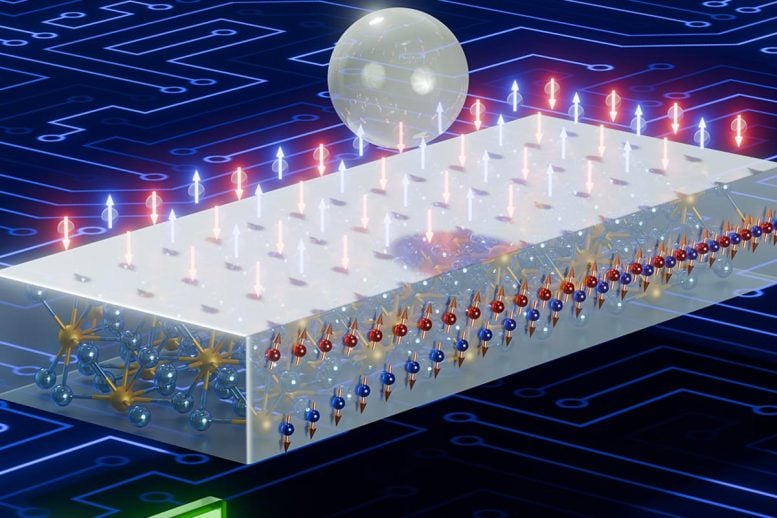
A team of researchers at the University of Minnesota has unveiled a powerful new <span class="glossaryLink" aria-describedby="tt" data-cmtooltip="
” data-gt-translate-attributes=”[{"attribute":"data-cmtooltip", "format":"html"}]” tabindex=”0″ role=”link”>alloy, Ni4W, that could radically reshape how electronic devices store and process information.
This metal can switch magnetic states without using external magnets—a leap that could reduce the energy consumed by everything from phones to data centers. Unlike exotic materials, Ni4W is made from abundant elements and works with standard manufacturing techniques, opening the door to faster, cheaper, and more sustainable electronics.
Faster, Smarter Computer Memory Ahead
Researchers at the University of Minnesota Twin Cities have uncovered new possibilities for improving computer memory, potentially making it faster and more energy-efficient.
Their findings were published in Advanced Materials, a peer-reviewed scientific journal. The team has also secured a patent for the technology.
As digital devices become more advanced, the need for faster and more efficient memory systems is growing. Scientists are exploring new materials that could enhance or replace current memory technologies while using significantly less power.
Breakthrough with Ni4W Alloy
In this study, the researchers introduced a more effective method of controlling magnetization in miniature electronic components. They used a material called Ni4W, which is made by combining nickel and tungsten. This unique, low-symmetry alloy was found to generate strong spin-orbit torque (SOT), a key effect used to control magnetism in advanced memory and logic devices.
“Ni4W reduces power usage for writing data, potentially cutting energy use in electronics significantly,” said Jian-Ping Wang, a senior author on the paper and a Distinguished McKnight Professor and Robert F. Hartmann Chair in the Department of Electrical and Computer Engineering (ECE) at the University of Minnesota Twin Cities.
The discovery could help lower electricity demands in everything from smartphones to data centers, offering a pathway toward more efficient and environmentally friendly technology.
Field-Free Switching: A New Possibility
“Unlike conventional materials, Ni4W can generate spin currents in multiple directions, enabling ‘field-free’ switching of magnetic states without the need for external magnetic fields. We observed high SOT efficiency with multi-direction in Ni4W both on its own and when layered with tungsten, pointing to its strong potential for use in low-power, high-speed spintronic devices.” said Yifei Yang, a fifth-year Ph.D. student in Wang’s group and a co-first author on the paper.
Ni4W is made from common metals and can be manufactured using standard industrial processes. The low-cost material makes it very attractive to industry partners and soon could be implemented into technology we use every day, like smart watches, phones, and more.
Confirmed by Theory and Experiments
“We are very excited to see that our calculations confirmed the choice of the material and the SOT experimental observation,” said Seungjun Lee, a postdoctoral fellow in ECE and the co-first author on the paper.
The next steps are to grow these materials into a device that is even smaller than their previous work.
Reference: “Large Spin-Orbit Torque with Multi-Directional Spin Components in Ni4W” by Yifei Yang, Seungjun Lee, Yu-Chia Chen, Qi Jia, Brahmdutta Dixit, Duarte Sousa, Michael Odlyzko, Javier Garcia-Barriocanal, Guichuan Yu, Greg Haugstad, Yihong Fan, Yu-Han Huang, Deyuan Lyu, Zach Cresswell, Shuang Liang, Onri Jay Benally, Tony Low and Jian-Ping Wang, 15 May 2025, Advanced Materials.
DOI: 10.1002/adma.202416763
In addition to Wang, Yang and Lee, the ECE team included Paul Palmberg Professor Tony Low, another senior author on the paper, Yu-Chia Chen, Qi Jia, Brahmudutta Dixit, Duarte Sousa, Yihong Fan, Yu-Han Huang, Deyuan Lyu and Onri Jay Benally. This work was done with Michael Odlyzko, Javier Garcia-Barriocanal, Guichuan Yu and Greg Haugstad from the University of Minnesota Characterization Facility, along with Zach Cresswell and Shuang Liang from the Department of Chemical Engineering and Materials Science.
This work was supported by SMART (Spintronic Materials for Advanced InforRmation Technologies), a world-leading research center that brings together experts from across the nation to develop technologies for spin-based computing and memory systems. SMART was one of the seven centers of nCORE, a Semiconductor Research Corporation program sponsored by the National Institute of Standards and Technology. This work is being supported by the Global Research Collaboration Logic and Memory program. This study was done in collaboration with the University of Minnesota Characterization Facility and the Minnesota Nano Center.
Never miss a breakthrough: Join the SciTechDaily newsletter.
